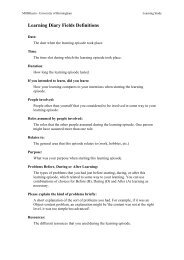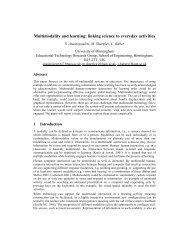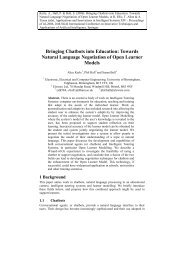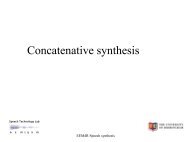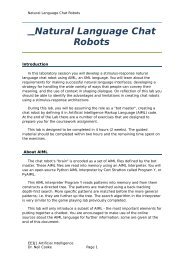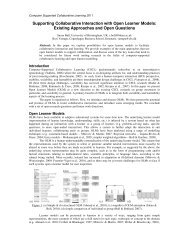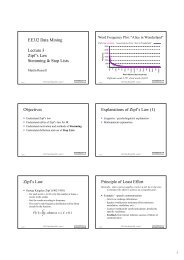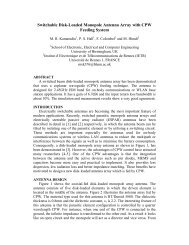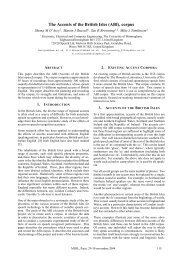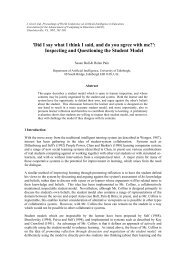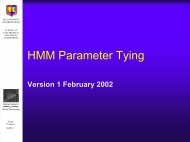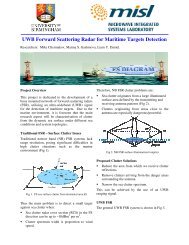Improved Structure-based Automatic Estimation of Pronunciation ...
Improved Structure-based Automatic Estimation of Pronunciation ...
Improved Structure-based Automatic Estimation of Pronunciation ...
Create successful ePaper yourself
Turn your PDF publications into a flip-book with our unique Google optimized e-Paper software.
Table 1: Condition for the acoustic analysis<br />
sampling 16bit / 16kHz<br />
windows 25ms length and 10ms shift<br />
training data about 75 sentences per speaker<br />
parameters MFCC + ∆ + ∆Power (25dim.)<br />
HMMs speaker-dependent, context-independent, and<br />
1-mixture monophones with diagonal matrix<br />
topology 5 states and 3 distributions per HMM<br />
monophones aa,ae,ah,ao,aw,ax,axr,ay,b,ch,d,dh,eh,er,ey,<br />
f,g,hh,ih,iy,j,jh,k,l,m,n,ng,ow,oy,p,r,s,sh,t,th,<br />
uh,uw,v,w,y,z,zh,sil<br />
the TIMIT sentences and students <strong>of</strong> different sets read different<br />
sentences. The eight sets cover the TIMIT sentences completely.<br />
Pr<strong>of</strong>iciency scores are also provided for all the students,<br />
which were manually given by five native teachers <strong>of</strong> American<br />
English with good knowledge <strong>of</strong> phonetics and Japanese English.<br />
In addition to speech and label data <strong>of</strong> Japanese English,<br />
in the corpus, the utterances <strong>of</strong> the same sentences read by 20<br />
native speakers <strong>of</strong> General American English (GA) are also included.<br />
18 <strong>of</strong> them read a half <strong>of</strong> the entire sentences and two<br />
read all the sentences. In this paper, a male speaker (M08) <strong>of</strong><br />
the two is used as a teacher commonly for all the 200 students.<br />
3.3. <strong>Structure</strong>-<strong>based</strong> analysis and GOP-<strong>based</strong> analysis<br />
Table 1 shows the acoustic analysis conditions and the number<br />
<strong>of</strong> AE monophones is 43. From the students, 200 sets <strong>of</strong> mohophone<br />
HMMs are trained. From the single teacher, eight sets<br />
<strong>of</strong> HMMs are trained, each corresponding to a sentence set in<br />
ERJ. From all the sets <strong>of</strong> HMMs, 208 129×129(=43×3) BD<strong>based</strong><br />
distance matrices are formed in total. Using the students<br />
<strong>of</strong> all the sets but set-6, the optimal definition <strong>of</strong> state-<strong>based</strong><br />
sub-structures is estimated. Selection <strong>of</strong> state pairs is incrementally<br />
determined to maximize the correlation between machine<br />
rating and human rating. Here, −D 1 or −D 2 is used as machine<br />
scores and they are calculated by matching a student’s<br />
sub-structure and the sub-structure <strong>of</strong> the corresponding sentence<br />
set <strong>of</strong> the teacher. Following the obtained optimal definition<br />
<strong>of</strong> sub-structures, those <strong>of</strong> the 26 students <strong>of</strong> set-6 are used<br />
as open data and compared to the teacher’s sub-structure. Then,<br />
correlation between machine and human is calculated.<br />
For comparison, the pronunciation pr<strong>of</strong>iciency is estimated<br />
as GOP (Goodness Of <strong>Pronunciation</strong>) scores, i.e. posterior<br />
probabilities <strong>of</strong> the intended phonemes given input utterances.<br />
GOP (o 1, ..., o T , p 1, ..., p N )<br />
= P (p 1, ..., p N |o 1, ..., o T )<br />
≈ 1 NX<br />
j<br />
1 P (o p i<br />
ff<br />
|p i)<br />
log<br />
, (3)<br />
N D pi max q∈Q P (o p i |q)<br />
i=1<br />
where T is the total length <strong>of</strong> given observation sequences and<br />
N is the number <strong>of</strong> the intended phonemes. o p i<br />
is the speech<br />
segment obtained for p i through forced alignment and D pi is<br />
its duration. {o p 1<br />
,...,o p N<br />
} correspond to {o 1,...,o T }. Q is the<br />
inventory <strong>of</strong> phonemes. The GOP was originally proposed in<br />
[12] and is widely accepted as pronunciation pr<strong>of</strong>iciency. Since<br />
GOP is probability ratio, it internally has a function <strong>of</strong> canceling<br />
acoustic mismatch between teachers’ HMMs and a learner’s<br />
utterance. In this paper, nine sets <strong>of</strong> HMMs are prepared to calculate<br />
the GOP. Eight sets are from eight sentence sets <strong>of</strong> the<br />
common teacher (M08). The other set is trained with all the<br />
utterances <strong>of</strong> the 20 native speakers <strong>of</strong> American English.<br />
Correlation coefficients<br />
1<br />
0.8<br />
0.6<br />
0.4<br />
0.2<br />
Relative differences<br />
Normalization in size<br />
No normalization<br />
0<br />
0 100 200 300 400 500 600 700 800 900<br />
Number <strong>of</strong> selected phoneme pairs<br />
Figure 6: Correlations with phoneme-<strong>based</strong> structure analysis<br />
Correlation coefficients<br />
1<br />
0.8<br />
0.6<br />
0.4<br />
0.2<br />
Relative differences<br />
Normalization in size<br />
No normalization<br />
0<br />
0 1000 2000 3000 4000 5000 6000 7000 8000<br />
Number <strong>of</strong> selected state pairs<br />
Figure 7: Correlations with state-<strong>based</strong> structure analysis<br />
Correlation coefficients<br />
1<br />
0.8<br />
0.6<br />
0.4<br />
0.2<br />
All the 20 teachers<br />
A single teacher<br />
0<br />
0 5 10 15 20 25 30 35 40 45<br />
Number <strong>of</strong> selected phonemes<br />
Figure 8: Correlations with GOP analysis<br />
3.4. Results <strong>of</strong> pronunciation pr<strong>of</strong>iciency estimation<br />
Results <strong>of</strong> pr<strong>of</strong>iciency estimation by phoneme-<strong>based</strong> structure<br />
analysis are shown in Figure 6. X-axis represents the number<br />
<strong>of</strong> selected phoneme pairs. The maximum is 43 C 2 =903.<br />
Colors indicate differences in normalization methods. The red<br />
curve is obtained using relative and structural differences <strong>of</strong><br />
Equation (2) and the green one is drawn by normalizing the size<br />
<strong>of</strong> sub-structures. The blue curve indicates no normalization.<br />
When we used finer units <strong>of</strong> structure analysis, state-<strong>based</strong><br />
structure analysis, as we expected, higher correlations were obtained,<br />
shown in Figure 7. Here, X-axis is the number <strong>of</strong> selected<br />
state pairs and its maximum is 43×3 C 2 =8,256. Similarly<br />
to Figure 6, colors indicate differences in normalization.<br />
Looking at both the figures, we can find easily that feature<br />
selection works effectively to improve the performance and that<br />
finer units <strong>of</strong> structure analysis, i.e. state-<strong>based</strong> sub-structures,<br />
are also beneficial. Checking each <strong>of</strong> them, we can find that<br />
the effect <strong>of</strong> normalization somewhat differs between them. In




